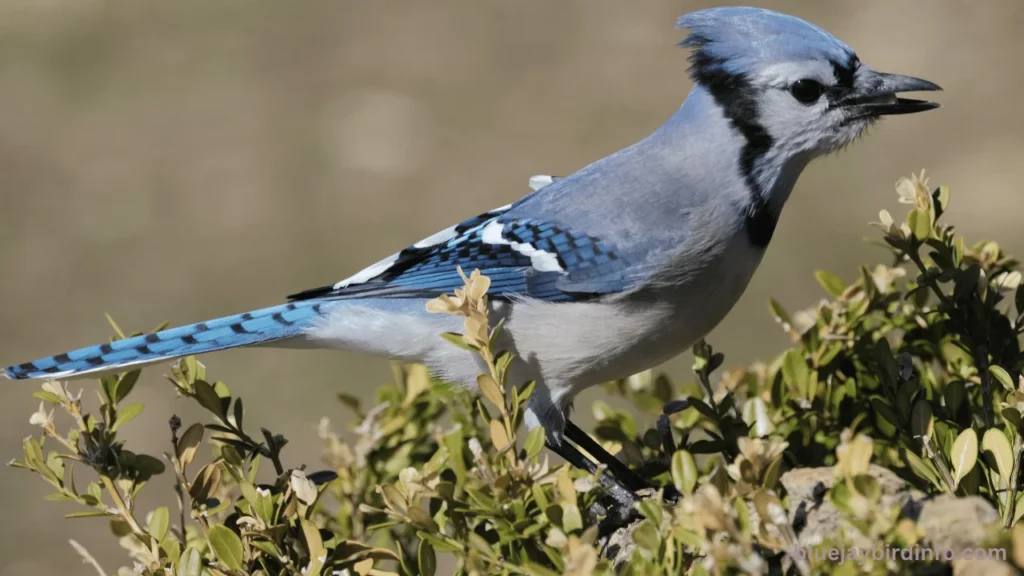Imagine waking up to the cheerful calls of a blue jay, its vibrant blue feathers flashing in the sunlight.
Known for their intelligence and playful antics, blue jays captivate bird lovers everywhere. They are not just beautiful to look at; they also exhibit remarkable behaviors, such as mimicking sounds and showcasing complex social structures. However, as enticing as the idea of having a blue jay as a pet may sound, the reality is far more complicated.
These wild birds are adapted to thrive in their natural habitats, and the challenges of keeping one in captivity are numerous and significant.
This article aims to delve into the fascinating yet intricate world of blue jays and why they are generally not suitable as pets.
While their striking appearance and lively personalities make them appealing, blue jays are wild creatures that require specific environments, diets, and social interactions that are nearly impossible to replicate in a domestic setting.
We will explore the numerous challenges and considerations involved in the prospect of keeping a blue jay as a pet, highlighting why these magnificent birds are best left in the wild.
Understanding the ecological role of blue jays and their natural behaviors is essential for anyone considering them as pets. Blue jays play a vital part in their ecosystems, participating in seed dispersal and helping maintain the balance of their habitats.
Moreover, keeping a wild animal as a pet raises ethical questions about animal welfare and the responsibilities of ownership. As we navigate through these critical points, we encourage you to think deeply about the implications of domesticating a creature that is meant to soar free.
Contents
Legal Restrictions
When considering the prospect of keeping a blue jay as a pet, it’s crucial to understand the federal and state laws that govern the possession of wild birds. In the United States, blue jays are protected under the Migratory Bird Treaty Act, which makes it illegal to capture, possess, or sell them without a special permit.
These regulations are in place to ensure the conservation of wild bird populations and to safeguard their natural habitats. Violating these laws can result in significant penalties, including hefty fines and possible imprisonment, emphasizing the seriousness of this issue.
Specific regulations regarding blue jays vary by state, but the general consensus is that these birds should remain in the wild. The ethical implications of owning a wild bird cannot be overstated.
Capturing a blue jay disrupts its natural life, often leading to stress and health issues. Wild birds like blue jays rely on their natural behaviors to thrive, and removing them from their environment can hinder their ability to socialize, forage, and reproduce.
By keeping a blue jay as a pet, not only is one risking legal consequences, but they are also causing potential harm to a creature that deserves to fly free and fulfill its role in the ecosystem. Understanding these legal and ethical considerations is essential for any potential bird owner.
Care Requirements
Caring for a blue jay requires specialized knowledge and commitment to meet their unique needs, which makes them unsuitable as pets for most people. In the wild, blue jays have a varied diet that includes insects, fruits, nuts, and seeds.
Replicating this diet in captivity can be challenging, as it demands a careful balance of nutritional components to ensure their health. Providing the right mix of foods, along with fresh water, is essential to prevent nutritional deficiencies.

Housing for a blue jay must be spacious and stimulating, allowing for adequate room to fly and exercise. A typical cage may not suffice, as these birds require an environment that mimics their natural habitat.
Enrichment is also crucial; blue jays are intelligent and curious, needing toys and activities to keep them mentally engaged. Socialization plays a significant role in their well-being, as blue jays are naturally social creatures. In a captive environment, lacking interaction can lead to boredom and stress, resulting in behavioral problems such as feather plucking or aggression.
Moreover, blue jays are susceptible to various health issues in captivity, especially if not provided with proper care. Stress from inadequate living conditions can weaken their immune systems, making them more vulnerable to diseases.
Overall, the complexities of providing adequate care for a wild bird like the blue jay highlight the significant challenges involved in keeping them as pets, making it crucial for prospective owners to reconsider their decision.
Ethical Considerations
The ethical implications of keeping wild animals, such as blue jays, as pets raise significant concerns about exploitation and potential harm to both the animals and their ecosystems. Wild birds are adapted to thrive in their natural habitats, where they fulfill vital roles in the environment, such as seed dispersal and insect control.
Removing them from their natural surroundings not only disrupts their social structures but also can lead to population declines, impacting the entire ecosystem.
Arguments for the captive breeding of wild animals for the pet trade often revolve around conservation efforts, suggesting that breeding programs can help preserve species.
However, this practice can also encourage the exploitation of wildlife, as demand for exotic pets may lead to illegal capturing and trading. Additionally, captive-bred animals often face challenges in adapting to the wild if they are ever released, further complicating conservation efforts.
Ultimately, the importance of preserving wildlife in their natural habitats cannot be overstated. Protecting natural ecosystems ensures that species like blue jays continue to thrive in the wild, supporting biodiversity and ecological balance.
By fostering a greater appreciation for wildlife in its natural environment, we can promote ethical practices that prioritize conservation over commodification, safeguarding the future of these remarkable birds.
Alternatives to Pet Ownership
While the allure of keeping a blue jay as a pet is understandable, there are numerous alternatives that allow you to enjoy their beauty and companionship without compromising their well-being. Birdwatching is one of the most rewarding activities that can connect you to blue jays and other wildlife. By observing these birds in their natural habitat, you can appreciate their unique behaviors, vibrant colors, and melodious calls—all while respecting their freedom.
Wildlife photography is another fantastic way to engage with blue jays. Capturing their antics and stunning plumage through your lens not only creates lasting memories but also fosters a deeper appreciation for these remarkable creatures. Sharing your photos can inspire others to value wildlife, leading to greater awareness and conservation efforts.
Supporting conservation efforts is yet another impactful alternative. Contributing to organizations that protect habitats, promote biodiversity, and advocate for wildlife can help ensure that blue jays and other species continue to thrive in the wild.
By choosing to engage with nature ethically, you not only enhance your own experiences but also play a part in preserving the ecosystems that sustain these beautiful birds. In this way, you can enjoy the presence of blue jays without the ethical dilemmas associated with pet ownership.
The Role of Wildlife Rehabilitation
Wildlife rehabilitation centers play a crucial role in caring for injured or orphaned wild animals, including blue jays. These facilities are staffed by trained professionals and volunteers who are dedicated to providing the necessary medical care and support for animals in distress.
When a blue jay is brought to a rehabilitation center, the process begins with a thorough assessment of its condition. Injuries, such as broken wings or infections, are treated, and the bird is provided with a safe and suitable environment to recover.
Rehabilitating blue jays involves not just medical treatment but also behavioral conditioning to prepare them for life back in the wild. Caregivers focus on ensuring that the birds can forage for food, interact with their environment, and engage in natural behaviors before their release.
This process is essential for helping blue jays regain their independence and successfully reintegrate into their habitats.
The ethical implications of wildlife rehabilitation are significant. By rescuing and rehabilitating injured or orphaned animals, these centers contribute to conservation efforts and help maintain healthy wildlife populations.
Moreover, they raise public awareness about the challenges faced by wild animals, encouraging people to be more considerate of their interactions with wildlife. Supporting wildlife rehabilitation not only benefits individual animals but also plays a vital part in preserving ecosystems and promoting biodiversity.

Conclusion
In summary, while blue jays are fascinating and intelligent birds, they are not suitable as pets due to legal restrictions, specialized care requirements, and significant ethical concerns. Keeping a wild animal like a blue jay can lead to stress and health issues for the bird, while also raising questions about the morality of exploiting wildlife for personal enjoyment.
Additionally, supporting wildlife rehabilitation efforts provides a more ethical avenue for interacting with these remarkable creatures without compromising their natural behaviors or habitats.
Ultimately, it is vital to protect wildlife in their natural environments and avoid practices that could harm them. As stewards of the planet, we have a responsibility to ensure that wild animals thrive where they belong, free from the constraints of captivity.
By advocating for the preservation of their habitats and respecting their place in the ecosystem, we contribute to a healthier world for both wildlife and humans.
To make a positive impact, consider supporting conservation organizations dedicated to protecting wildlife and their habitats. Additionally, explore ethical alternatives to pet ownership, such as birdwatching or wildlife photography, to appreciate the beauty of blue jays and other wildlife without the need for captivity.
Also, read other articles related to Blue Jay Habits!
FAQ’s
Can blue jays be kept as pets?
No, blue jays are wild birds and are not suitable for captivity due to their specific needs and behaviors.
Are there legal restrictions on keeping blue jays?
Yes, many states and federal laws protect blue jays, making it illegal to keep them as pets without special permits.
What are the care requirements for blue jays?
Blue jays require a specialized diet, adequate space, and social interaction, which can be difficult to provide in captivity.
What are the ethical concerns of keeping wild animals as pets?
Keeping wild animals can lead to their exploitation and can harm both the animal and the environment.
How can I enjoy blue jays without keeping them as pets?
Birdwatching, wildlife photography, and supporting conservation efforts are great ways to appreciate blue jays in their natural habitats.
What is wildlife rehabilitation?
Wildlife rehabilitation involves caring for injured or orphaned wild animals with the goal of releasing them back into their natural environments.








